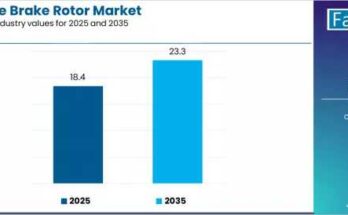The global ambulance cot market is projected to grow from US$ 786.3 million in 2024 to approximately US$ 1.13 billion by 2034, reflecting a compound annual growth rate (CAGR) of 3.7 percent, according to a recent market intelligence report.
This growth is being propelled by increasing emergency medical services (EMS) demand, a rising number of cardiovascular and chronic disease cases, expanding healthcare infrastructure, and the aging global population. These factors are driving investments in reliable, high-performance patient transport equipment — particularly ambulance cots.
Market Drivers
-
Rising EMS Adoption: As private and public EMS providers expand, demand for high-quality cots — especially those that support safe, rapid loading and transport — is expanding.
-
Aging Population & Chronic Illness: Elderly patients and individuals with chronic conditions require frequent medical care, contributing to increased usage of ambulances and cots.
-
Healthcare Investment: Higher healthcare spending, better funding for ambulance fleets, and medical tourism are raising the bar for patient handling standards.
-
Air & Private Ambulance Expansion: Growth in air ambulances and private EMS services is boosting the demand for electric and pneumatic cots that offer automation and efficiency.
Market Segmentation & Trends
The report divides the market based on technology (manual, pneumatic, electric), product type (emergency vs transport), and end users (EMS providers, hospitals, ambulatory centers), and highlights how each segment contributes to growth.
-
By Technology:
-
Manual Cots: Expected to maintain significant share; valued at around US$ 383.6 million in 2024, with a projected CAGR of 3.5%.
-
Pneumatic & Electric Cots: These segments are gaining traction, driven by automation and ease-of-use, especially in time-critical scenarios.
-
-
By Product Type:
-
Emergency Cots: Estimated to command about 58.5% of market revenue by 2034. These are crucial for rapid, safe transfer in accident or cardiac situations.
-
Transport Cots: Widely adopted in non-emergency transfers, ambulatory care, and inter-facility patient movement.
-
-
By End User:
-
Hospitals: Account for about 34.1% of the market by 2034, driven by trauma care and patient transfer needs.
-
EMS/Service Providers & Ambulatory Centers: These segments are expanding rapidly, especially in regions where EMS infrastructure is scaling up.
-
Regional Insights
-
North America: Leading region with an expected 34.6% share of global revenue by 2034. The U.S. alone is projected to grow at a 4.5% CAGR, reaching approximately US$ 379.9 million by 2034.
-
East Asia & China: Rapid market growth projected in China, where the ambulance cot market is expected to grow at 5.2% CAGR, reaching US$ 108.4 million by 2034. The elderly population and expanding EMS ecosystem are major contributors.
-
South Asia & Pacific: Expected to contribute significantly to market share (approx. 21.2% by 2034), supported by increasing EMS investments and improving healthcare access.
Challenges & Market Risks
-
High Regulatory Costs: Ambulance cots must meet stringent regulatory requirements, often making them expensive and limiting price-sensitive adoption.
-
Reimbursement Pressure: The cost of EMS services, including cot procurement, can be prohibitive in regions with limited reimbursement or subsidization.
-
Operational Complexity: Automated or powered cots require specialized maintenance, increasing total cost of ownership for EMS providers.
-
Infrastructure Gaps: In underdeveloped regions, limited ambulance fleets and poor EMS infrastructure may restrict adoption of advanced cot technologies.
Competitive Landscape
Key global players are actively innovating and expanding their footprint in the ambulance cot space. Major companies include:
-
Hausted Patient Handling Solutions
-
Stryker
-
Pedigo USA
-
Amico
-
Ferno EMS
-
Hill-Rom
-
Spencer India Technologies Pvt. Ltd.
These companies are focusing on R&D, manufacturing high-performance electric and pneumatic cots, forming partnerships with EMS providers, and optimizing supply chains to meet global demand.
Future Outlook & Emerging Trends
Looking ahead to 2034, the ambulance cot market is expected to evolve significantly:
-
Smart, Automated Cots: Increasing demand for pneumatic and electric cots with automatic lift, drop-lock, and patient stabilization features.
-
Lightweight Materials: Use of advanced materials to reduce the weight of cots — easing transport and reducing strain on paramedics.
-
Modular & Multi-Platform Systems: Cots that are compatible across ambulances, air medivac units, and hospitals.
-
Rural & Emerging Market Penetration: Greater adoption in emerging economies due to expanding EMS infrastructure, medical tourism, and public-private partnerships.
-
Safety & Ergonomics: Enhanced designs that reduce paramedic injury risk, improve patient comfort, and comply with global safety standards.
Browse Full report : https://www.factmr.com/report/4166/ambulance-cots-market
Quote from Market Analyst
“Ambulance cots are no longer just basic stretchers — they are becoming smarter, safer, and more vital to EMS operations. With the market expected to cross US$ 1.13 billion by 2034, manufacturers and EMS providers must focus on innovation in automation, ergonomics, and lightweight design to meet evolving global demand.”
About the Report
This report provides an in-depth analysis of the global ambulance cot market from 2024 to 2034. It covers market size, segmentation by technology and product type, regional insights, major trends, and competitive dynamics, offering actionable intelligence for key stakeholders including manufacturers, EMS providers, and healthcare institutions.



